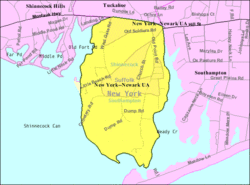Shinnecock Reservation facts for kids
Quick facts for kids
Shinnecock Reservation, New York
|
|
|---|---|

The Shinnecock Nation Cultural Center and Museum in 2007
|
|

Map of Shinnecock Reservation
|
|

Location within the state of New York
|
|
| Country | United States |
| State | New York |
| County | Suffolk |
| Area | |
| • Total | 1.3 sq mi (3.4 km2) |
| • Land | 1.3 sq mi (3.4 km2) |
| • Water | 0 sq mi (0.0 km2) |
| Elevation | 203 ft (62 m) |
| Population
(2020)
|
|
| • Total | 819 |
| • Density | 626.5/sq mi (241.9/km2) |
| Time zone | UTC-5 (Eastern (EST)) |
| • Summer (DST) | UTC-4 (EDT) |
| ZIP code |
11968
|
| Area code(s) | 631 |
The Shinnecock Reservation is a special area of land set aside for the Shinnecock Indian Nation. It's located in the town of Southampton in Suffolk County, New York, United States. This reservation is on the eastern side of Long Island, near Shinnecock Bay. It is the most easterly of the two Native American reservations in Suffolk County.
In 2020, about 819 people lived on the reservation. Many other Shinnecock tribal members live nearby, off the reservation.
Geography of the Reservation
The Shinnecock Reservation covers a total area of about 1.3 square miles (3.4 square kilometers). All of this land is dry land; there are no large bodies of water within the reservation boundaries.
Population and People
The number of people living on the Shinnecock Reservation has changed over the years. Here's how the population has grown:
| Historical population | |||
|---|---|---|---|
| Census | Pop. | %± | |
| 1910 | 171 | — | |
| 1920 | 112 | −34.5% | |
| 1930 | 194 | 73.2% | |
| 1940 | 156 | −19.6% | |
| 1950 | 183 | 17.3% | |
| 1960 | 234 | 27.9% | |
| 1970 | 174 | −25.6% | |
| 1980 | 297 | 70.7% | |
| 1990 | 375 | 26.3% | |
| 2000 | 504 | 34.4% | |
| 2010 | 662 | 31.3% | |
| 2020 | 819 | 23.7% | |
| U.S. Decennial Census | |||
In 2010, there were 662 people living on the reservation. Most of the people living there, about 76.6%, identified as Native American. Other groups included White (6.04%), Black or African American (4.53%), and Asian (0.45%). About 12% of the population identified as being of two or more races.
Many families on the reservation have children under 18 living with them. The population includes people of all ages, from young children to elders over 65.
Federal Recognition and Economic Development
The Shinnecock Nation worked for many years to be officially recognized by the United States government. This official recognition, called federal recognition, was formally granted in 2010.
Getting federal recognition is very important for Native American tribes. It means the U.S. government officially recognizes them as sovereign nations. This allows the tribe to make more decisions about their own land and future.
One way the Shinnecock Nation plans to create jobs and improve life for its members is through economic development. They have discussed plans for a Class III casino. This would help the tribe earn money to support their community and programs.
The tribe and local officials have talked about where a casino might be built. They want to find a location that works well for everyone. This includes considering traffic and how it might affect nearby communities.

